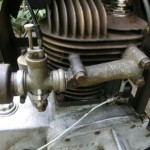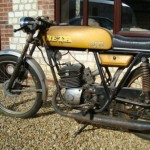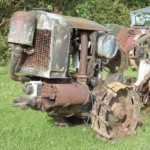Home › Forums › The Machinery Forums › Pedestrian operated machines › Smokey F.15 – well, thats odd
- This topic has 25 replies, 5 voices, and was last updated 6 years, 5 months ago by
 vhgmcbuddy.
vhgmcbuddy.
-
AuthorPosts
-
November 3, 2017 at 4:28 pm #26977
 vhgmcbuddyMember
vhgmcbuddyMemberSo, the Autobarrow (other thread) has been great – great quality, good design, works perfectly. I have done a few bits and bobs to the engine – just general servicing really, which included refilling it with the exact oil described in the manual to the level described in the manual (if anything a little less) and….. I smokes like a battle field!?
so, took the head off and had a look at the bore from the top. it was perfect. I mean nearly like new – honing marks visible. I then cleaned it and the valves up – the value guides seemed ok too -so, could it be that the issue was on the bottom half of the bore – sticky/broken/aligned rings? glazing? – who knows..
Today stripped the piston out and found: –
1 – a PUDDLE of oil on top of the piston!
2 – the engine is like new inside
3 – the breather works perfectly (not that there is much to go wrong)
4 – the rings and bore are perfectSo, all that is left is the valve guides – although I cant see why an engine that has so little wear anywhere else would have guides that were that far gone? – also, I haven’t removed them for the 2nd time yet but they didn’t seem too bad last time?
Any more ideas before I sign-up the engineering shop to fit new guides?!
Ps – I cant believe such a simple – in great condition – engine can be giving so much trouble!
November 3, 2017 at 9:47 pm #26994andyfrost
ParticipantHave you actually removed the rings and measured the gap in the bore. I’m a great fan of the F15 , and have one on a Howard Bantam , and find it easily out performs the original Mk15.
I wouldn;t have thought it was guide problems , as you have told us of the oil on the piston , I would suspect piston ring problems.Andy.
November 4, 2017 at 1:08 am #27010 wristpinParticipant
wristpinParticipantHave you actually removed the rings and measured the gap in the bore
If you have a look at “spec page” of the F15 manual scan that I posted there is quite a lot of info on ring sizes and end gaps – 6 – 11 thou, I think.
Take each ring off the piston – keeping them in order and correct orientation and poke each one in turn into the running section of the bore using the piston upside down to keep them square and then check the end gaps . Then push them down to the unworn area at the bottom of the bore ( remember that the oil control ring is at the very bottom of the piston) and check / compare again. That will give you an idea of what and where the wear is but, of course it is more meaningful if you have some new rings as a “control” .November 4, 2017 at 4:19 pm #27011 vhgmcbuddyMember
vhgmcbuddyMemberI am about to check the ring gap, but initial eyeballing would suggest its tiny!
also, and I am equally confused as to why it would be so, the exhaust valve moves approx. 1mm side to side in the guide – there is about 0.01 to 0.02 mm variation along the valve shaft, the inlet less so but a significant build up of carbon in the inlet port would suggest that too much oil is arriving under the valve?
Lastly I see that the valves run directly in the block – so its not as if I can just get more pressed in!
I am going to go and check the ring gaps now (watch this space) but I really think its the guides – I wonder if fitting new valves would be enough? or maybe I could get proper, phosphor bronze guides from something else and have the block machine to fit?
Fascinating stuff! and like you I am a real fan of this engine too, lovely quality and clever engineering – I love the fact that, to allow the gearing in the reduction box they just take the drive off the cam shaft….
November 4, 2017 at 5:16 pm #27012 vhgmcbuddyMember
vhgmcbuddyMemberYep, all ring gaps under 0.3mm – so fine according to the manual….
So, I will be looking into getting some suitable phos-bronve guides and having the block machined to fit – what does everybody think? any ideas what/where I could get them?
Also I have been in touch with Meetens (very knowledgeable and great service), I will get all my gaskets and what not from them and I think they might have an idea about what guides I can retro-fit?
November 4, 2017 at 6:04 pm #27013 wristpinParticipant
wristpinParticipantSo how do the valve stems measure up against the book spec?
Might be worth asking Paul at Meetens whether there are any over size valves stems . Then it would just be a reamer job.
As far as getting guides goes, an engine reconditioners, possibly one specialising in motor cycles may be a good starting point.November 4, 2017 at 6:11 pm #27014 stuartParticipant
stuartParticipantI have fitted many 1/4″ valve guides in Briggs and Stratton engines over the years (the smaller size engines where the alloy cylinder block is also the valve guide material).You have to ream the worn alloy guide first,then press the replacement brass guide in and then finish ream the new guide all using the B+S special tools.I would guess the repair procedure is the same for the Villiers engines.I have also used the Briggs and Stratton special tools for servicing worn valve guides in the alloy Suffolk Punch 98cc and 114cc engines.What diameter are the Villiers F15 valves ????
November 4, 2017 at 6:50 pm #27015andyfrost
ParticipantOversize valves are available for the F15 , so no real need to go to all the hassle of machining guides to fit , the idea being to ream out to fit the oversize guides.
Andy.
November 4, 2017 at 7:19 pm #27016 vhgmcbuddyMember
vhgmcbuddyMemberOh, thanks all. I will talk to Meatons.
Its odd that the manual – which I just bought as I am the kind of person who likes to flick through such things of an evening – doesn’t really talk about the guides much but as you say it does mention oversize jobs being available – I have never come across oversized valves and assumed that they meant the head not the shaft! not sure why.
So that’s good news, although might like to fit phoz-bornze jobs just because I like to tinker and improve things and I might be a bit of a weak point if it has gone bad so quickly?
stuart, where are you – maybe you could do this for me? I am in Epsom….
November 4, 2017 at 10:15 pm #27018 stuartParticipant
stuartParticipantI am in Northamptonshire.
November 4, 2017 at 10:37 pm #27019 wristpinParticipant
wristpinParticipantOne of my F15s is 50 years old . Around 20 years ago although it was running fine, I did a top end overhaul and the valve stems were so worn that no measuring was needed – just Mk1 eyeballs .Put it back together and ordered new valves which are still in their wrapping, still running fine with no smoke!
If you want to repair yours I’d settle for o/s valve stems it might even be that there’s not enough metal available to accommodate inserted guides and you could end up ruining a good engine.November 5, 2017 at 8:53 am #27021 charlieKeymaster
charlieKeymasterThe pdf file below is an extract from the workshop manual for Mk10, 12 and 15 not F15 engines, but may be of some help.
Attachments:
November 5, 2017 at 10:41 am #27024 vhgmcbuddyMember
vhgmcbuddyMemberwristpin, good point re the material quantity in the block – don’t want to mess-up the engine for no other reason than over-enthusiasm! Also, I have a theory that this engine is strange in having badly worn guides but well seating valves and the bore/piston/rings that are in good nick = great compression. This makes me think that the below piston pump pressure will be very healthy and forcing oil around more then had the whole engine been as worn as the guides?
I meant to test this theory by running the engine for a while without the crankcase vent ball in place but didn’t get around to it in the end.It would seam Charlie that the maintenance manual for the mk10 to 15 engines is quite a lot better than for the F15 which is very sparse and not that much more detailed then the operating manual really. I am interested to see that, assuming you had the right tools, you could ream the guides and re-cut the seats in you garage by hand – I was thinking that an engineering shop with a big mill would be the only way to go – i would like to buy the tools to do it myself but it might not be cost-effective for one engine? where should i look for them?
stuart, this is quite a way but i am in Birmingham often enough, it might be an option – i will cost up the tools and see!
Lastly, i cannot get hold of an exploded diagram for the reduction gearbox, i could be going mad here but i seem to remember a steal shim being used on the splined cog that comes off the camshaft but for the life of me i cant find it – i don’t mean the large phos-bronze job that goes between the crankshaft and the output shaft – i have that. Does anyone have an assembly pic of the box?
It could all be a figment of my imagination as i have just finished re-assembling an old Ossa trial bike engine that is riddled with shims!!November 5, 2017 at 12:18 pm #27025 wristpinParticipant
wristpinParticipantRunning the engine without the crankcase breather valve could be counter productive in that while providing an exit for the air displaced on the downward piston stroke, it should seal on the upward stroke creating a negative pressure area in the crankcase to keep the engine oil tight. It’s possible that some of your oil burning is due to the ball valve not sealing properly and not creating that negative pressure.
The F15 used two versions of the breather, the ball one that you have and a (later?) poppet valve similar to that used on the F12 Sloper. That was integral with the valve chest cover, so is an easy swap. Paul at Meetens is the man to advise whether it might be worth doing.I too had noticed the difference in the amount of useful information provided in the earlier Mk series manual compared with the F15 one that I posted, but in fairness it does mention oversized valve stems and reaming – buried in the text at the foot of page 13.
Attachments:
November 5, 2017 at 4:44 pm #27028 vhgmcbuddyMember
vhgmcbuddyMemberThat makes sense re the breather
My search for the tools to ream/cut the valves as drawn a complete blank, any ideas? – I wonder if Meetens has something? I will try tomorrow…
and a diagram of the reduction box?
-
AuthorPosts
- You must be logged in to reply to this topic.




